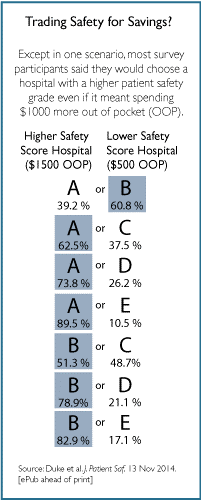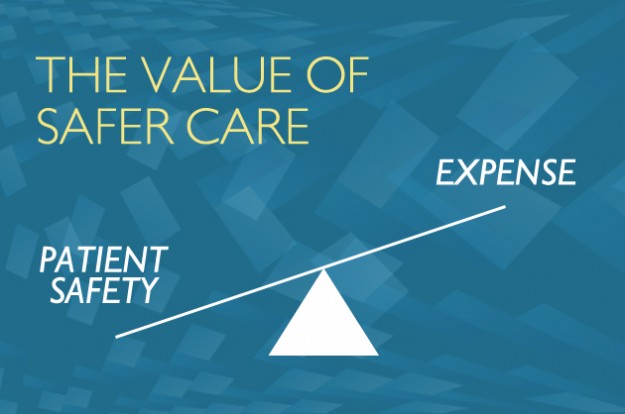What is it worth to be treated in a hospital with a stellar patient safety record rather than one with lower performance?
For a large majority of survey participants in a recent study by researchers from the Altarum Institute and Drexel University, the answer is quite a lot. Published online last month in the Journal of Patient Safety, the study found that most respondents would choose a hospital with a higher patient safety rating, even if it meant paying an additional $1000 in out-of-pocket costs. The results give hope that patient safety performance will be a powerful motivator in hospital choice — and thus in compelling hospitals to improve.
In the survey, roughly 2600 individuals were introduced to the concept of patient safety and what better safety ratings mean: “fewer problems such as infections, injuries, medication errors and deaths during surgery.” They were then introduced to the Leapfrog Group Hospital Safety Score, a composite patient safety measure that assigns a letter grade to each hospital. Each participant was presented with one of 30 scenarios, in which they had to choose between two hospitals with different Hospital Safety Scores, out-of-pocket costs and total price.
 As one might expect, nearly 100 percent of patients preferred the safer hospital when their out-of-pocket cost was the same or less than the hospital with the lower safety score. Nearly 60 percent of patients were willing to trade down from an “A” hospital to a “B” hospital if that meant saving $1000. But less than 40 percent would make the trade-off from an “A” to a “C” hospital, and in other scenarios, an overwhelming majority of patients said that they would seek safer care despite it costing them more (see graphic).
As one might expect, nearly 100 percent of patients preferred the safer hospital when their out-of-pocket cost was the same or less than the hospital with the lower safety score. Nearly 60 percent of patients were willing to trade down from an “A” hospital to a “B” hospital if that meant saving $1000. But less than 40 percent would make the trade-off from an “A” to a “C” hospital, and in other scenarios, an overwhelming majority of patients said that they would seek safer care despite it costing them more (see graphic).
These were hypothetical scenarios, and we know that patients consider a mix of factors when choosing a hospital — such as their primary care physician’s recommendations, other people’s experiences, magazine rankings, reputation, location and even whether there is free parking.
There is little evidence that publicly reported patient safety measures are a major part of that equation for most actual patients. That could be due to a number of factors. People may be unaware of the issue of preventable harm, or it might seem like a vague concept to them. They may choose to ignore it, keeping faith that they won’t experience a preventable harm. Or, even if they seek out the safety and quality data, they may be overwhelmed by the sheer number of measures to track down and sift through. They may not be aware of composite scores such as the Leapfrog Group’s.
This study hints at what might be needed for patient safety performance to get the attention it deserves in these decisions.
- Public awareness. As I discussed in a recent blog post, patient safety leaders have done a poor job of speaking to the public about the scope of preventable patient harm. We need to engage civic groups and other organizations to rally around this cause.
- Composite measures. Rather than assume that patients will evaluate and synthesize the various patient safety measures on their own, composite measures such as the Leapfrog safety score presents a simple, easy to understand letter grade. If users want to drill down, they can see how hospitals perform in specific safety areas. (I should disclose that I am part of a nine-person panel that advises the Leapfrog Group on the Hospital Safety Score. Additionally, Matt Austin, an assistant professor with the Johns Hopkins Armstrong Institute, facilitates the score.)
- Advance measurement science. While composite scores are a step in the right direction, they are making the best of the still-young science of patient safety measures. We need to continually push to advance this science. For example, we need a greater number of valid measures that capture patient outcomes.
If you’re shopping for a new car, you could quickly track down the well-tested, simple safety ratings from the Insurance Institute for Highway Safety or the National Highway Traffic Safety Administration. People know that good ratings mean less chance of death or serious injury should they have an auto accident, as well as an increased ability to avoid crashes in the first place. A low rating certainly is a red flag when you’re considering a particular model. For patients selecting a hospital, safety ratings should one day be treated the same way.

I had the pleasure of working with Dr Peter Pronovost at JHH as an OR Nurse when he was an anesthesia resident. I love reading this patient safety information.
It’s great to hear from you, Valerie. Thank you for reading and for the kind words.
Hi Peter,
I know exactlly what you are talking about.
If it's real in US, can you imagine how big is the problem of warning patients about our dangerous healthcare processes in Brazil?
I've got quite interested in the Leapfrog Hospital Safety Score... I myself, criated a "tupiniquim*
score" in my hospital late 2006 - a "1 to 10" scale on outcome results based on the IHI procecess for their 100K LIVES campaign. It was quite "intuitive". Everybody knows that "an 8" is better than "a 6" .
But we really don't have good and enough robust metrics on patient safety... yet !!
* "tupiniquim" is one indigenous race in northestearn Brazil.
Laura – Thank you for the comment. Patient safety is certainly an issue everywhere. Was your score circulated at your hospital alone or did it apply to other institutions as well?
There is an underlying thread to our patient safety work that assumes patients have choices when seeking care. That's not the case for most of the patients we serve--yet safety is essential to their care. I know the financial rewards of being a high scoring organization are what drive the system, but patient safety is its own reward!
Excellent point about patient safety being its own reward. We need to help advance patient safety metrics so that they are more valid and meaningful for everyone involved.
It's about time someone wrote about this.
Pingback: Weekly Must Reads in Patient Safety (Dec 19, 2014) | Physician-Patient Alliance for Health & Safety
Pingback: Top 16 Patient Safety Must Reads of 2014 | Physician-Patient Alliance for Health & Safety
While this survey does show that patients (and purchasers) do really care about quality, it only perpetuates the false belief that higher price buys higher quality--which is far from the truth.
My organization developed The $0 Card, a marketplace between providers and purchasers, in which providers offer upfront, bundled transparent prices for certain procedures. The process has attracted several high-value institutions with the volume, experience and outcomes needed to take risk on bundling and offer true "market prices" (that are 40-80% lower than PPO prices).
Yet the biggest obstacle we encounter comes from that cost-quality myth. As one person put it, "Bargain care kinda freaks me out." Is medicine the only field in which you can offer a better product at a lower cost and be met with skepticism? How do we change that?
Dr. Provonost,
Excelent !!
I work with quality and patient safety in Brazil. Despite the daily efforts, we seem so far from a real safety culture in my country.
I follow your work for a long time. Your articles are inspiring...
Congratulations!
Thank you!
Pingback: The Value of Safer Care | Doctella
Your point of view caught my eye and was very interesting. Thanks. I have a question for you.
I don't think the title of your article matches the content lol. Just kidding, mainly because I had some doubts after reading the article.
There is definately a lot to find out about this subject. I like all the points you made Enjoy live tv ary news urdu — 24/7 Urdu headlines. crisp HD playback. breaking alerts, reportage. mobile‑friendly interface.
Your article helped me a lot, is there any more related content? Thanks!